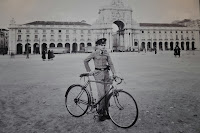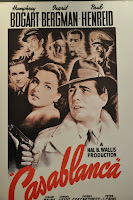We often forget the role Portugal played during the World War II once having declared its neutrality in September 1939 became the "last frontier" and a gateway to the Atlantic as refugees attempted to escape to America.
I have today been to a temporary exhibition held at Torreão Poente which is extremely well organised providing the visitor with a thorough image of what the atmosphere of the epoch was and allowing one to have access to copies of documentation and old photos that one wouldn't otherwise have easy access to.
"When I went through Portugal in December 1940 on my way to the US, Lisbon seemed to be a sort of bright, sad paradise. There was a lot of talk then about an imminent invasion, and Portugal was holding onto the illusion of its happiness.Lisbon, which had built the most beautiful exhibition of the world, was smiling with a slightly pale smile; like that of mothers who, not having news from a son who's at war, make an effort to save him just through their trust."
Antoine de Saint Exupery in Lettre à un ottage.
Antoine de Saint Exupery in Lettre à un ottage.


From 1940 on as rumours of an imminent Nazi and Spanish invasion spread (code name operation Felix) exercises and preparatory alarms against a possible attack became part of everyday life.
Refugees being anxious about news and correspondence from relatives spent most of their time in the post-office and those who were kept waiting for a visa or a plane ticket idled in Cafés and parks, hotel lobbies and cinema theatre.
The press, radio and cinema were the means to get news from the remote conflicts in an atmosphere of harsh ideological conflict and intricate espionage networks.

Post office advertisement (left). Postman in Lisbon before postal delivery (right).

Listening to the BBC - 15th of December 1941.


Calouste Gulbenkian with Saudi Arabian Sheiks at Lisbon airport in 1947 supposedly organising the evacuation of people at risk in occupied Europe.

Freda Josephine McDonald, later to be known as Josephine Baker served during the second World War singing for soldiers and above all having become a sort of underground courier for the resistance, she came to Lisbon (the only place where it was possible to hand information to the British in a rather safe way). She is said to have brought photographs and information about the German positions in France sewn into the lining of her mink coat and inside her bra, having twice brought dozens of pieces of information written in invisible ink amidst her music scores.
Queue of refugees at the door to the premises of the Foreign Residents' Police - Lisbon, 1939

Cars with foreign licence plates - Lisbon April 1940 (left).
But Lisbon was also used as a platform for exchanging prisoners and diplomats.

The photos depict a ship with axis diplomats about to be exchanged for diplomats of the allies.
"The ship weighs anchor in the darkness of the night
It was slowly turned and tugged down the Tagus
The centenary exhibition shone like in a fairy tale as we passed
Its magic light was the last image we had of Europe surrounded in mourning."
Alfred Döblin


VE certificate delivered by a private English School in Lisbon to its students (left). Celebrating Victory Day in the streets of Lisbon (right).
It is really worth visiting this temporary exhibition which will be on till the 15th of December.
Though the images related to what could be considered as a distant past I couldn't help thinking on the many who still nowadays desperately attempt to flee their war-torn countries or those under wars and conflicts and may never make to a haven as Portugal was for some back then.


















No comments:
Post a Comment